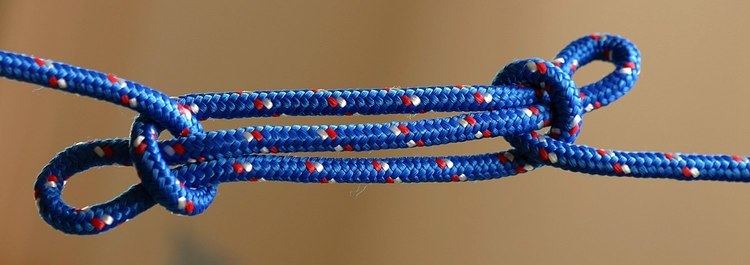Category Shortening Related | Origin 1627[1] Releasing Non-jamming | |
 | ||
Typical use Provides loops, shortens or removes slack from a rope, bypasses a frayed section of rope Caveat Spills if not under tension. | ||
A shank is a type of knot that is used to shorten a rope or take up slack, such as the sheepshank. The sheepshank knot is not stable. It will fall apart under too much load or too little load.
Contents
- Construction methods
- Usage
- Disadvantages
- Man owar sheepshank
- Sheepshank with Marlingspike hitches
- Kamikaze knot
- Use
- Catshank
- Dogshank
- References
The knot has several features which allow a rope to be shortened:
Construction methods
A sheepshank knot may be constructed as follows: ...
An alternative method for quickly constructing a sheepshank is as follows:
The result is a flattened loop which is held at each end by a half hitch. If the sides of the flattened loop are pulled away from each other, the flattened loop ends pull out of the half hitches and the knot falls apart, but if the free ends are pulled taut then the knot remains secure.
Usage
Sheepshank knots are typically used for securing loads to trucks or trailers, and in sailing applications.
Disadvantages
The sheepshank was developed before the use of modern "slippery" synthetic ropes. Constructed from such ropes, under load, it can fail. It is strongly advised that an alternative knot be used.
Man-o'war sheepshank
The man-o'war sheepshank is a sheepshank knot with a Handcuff knot in the middle. This configuration with the half-hitches formed close to the central knot is used in rope rescue and is called a Fireman's chair knot.
Sheepshank with Marlingspike hitches
This version of the sheepshank is tied by using slipknots instead of half-hitches. It is one of the safest sheepshank variations.
Kamikaze knot
The kamikaze knot is a slight variant of the sheepshank. To perform a kamikaze knot, a sheepshank is first constructed. Whilst holding sufficient tension on the sheepshank so it will not slip out, the middle rope is sliced. This allows climbers rappelling down cliff faces to keep most of the rope used for the rappel, by tying the knot at the top, and shaking the rope when they reach the bottom. The shaking disconnects the knot at the top, allowing the longer section of rope to fall, meaning only a small amount of rope is retained by the anchor at the top of the cliff. Thin or slippery rope is unsuitable for such a knot, as it can easily slip, and the knot should not be performed unless desperately needed.
Use
Although certainly not invented by him this variant of the sheepshank knot appeared in an episode of the TV show Man Vs Wild. Bear Grylls uses a modification of this knot by cutting one of the lengths of rope in the knot, while rappelling down an edge during the Ireland episode of Man vs. Wild in order to retrieve his rope at the bottom by severing the middle leg of the sheepshank knot before his descent. He refers to it as a "Kamikaze" knot.
Catshank
The catshank is a variant of the sheepshank, clinched by two overhand knots with the bights passed through the twists (one end of the rope must be available to tie the overhands).
Dogshank
The dogshank is a variant of the sheepshank, where the eyes formed at each end have the ends of the rope passed through them to prevent the knot from spilling. At least one end of the rope must be available.
Also called pouch knot it may be made mostly for the hammock like space it creates.
The dogshank can be thought of as two opposite bowlines where
The dogshank can also be thought of as two opposite sheet bends where
Further reading:
